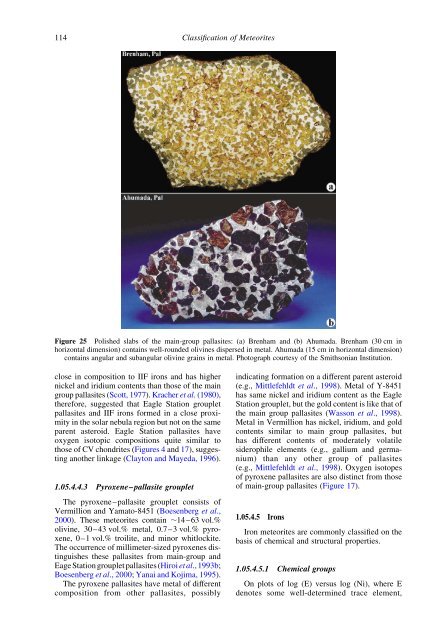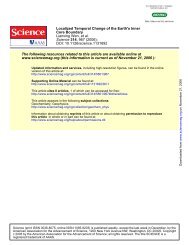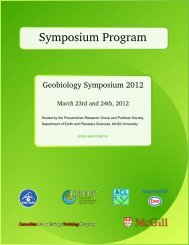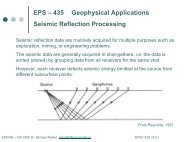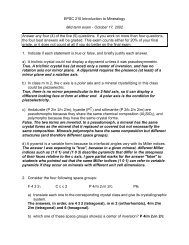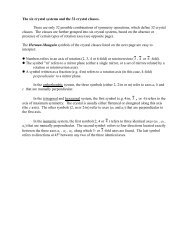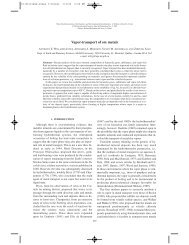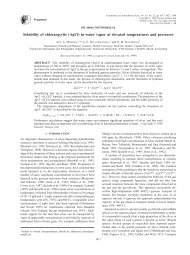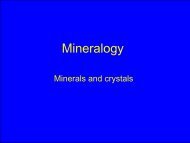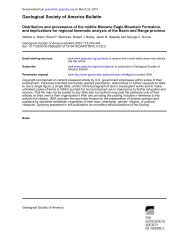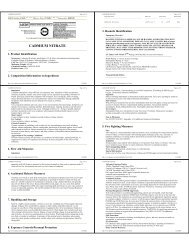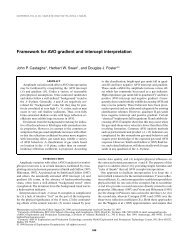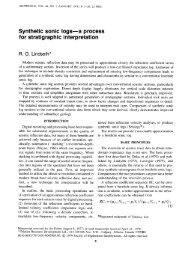05 Classification of.. - Department of Earth and Planetary Sciences
05 Classification of.. - Department of Earth and Planetary Sciences
05 Classification of.. - Department of Earth and Planetary Sciences
You also want an ePaper? Increase the reach of your titles
YUMPU automatically turns print PDFs into web optimized ePapers that Google loves.
114<br />
<strong>Classification</strong> <strong>of</strong> Meteorites<br />
Figure 25 Polished slabs <strong>of</strong> the main-group pallasites: (a) Brenham <strong>and</strong> (b) Ahumada. Brenham (30 cm in<br />
horizontal dimension) contains well-rounded olivines dispersed in metal. Ahumada (15 cm in horizontal dimension)<br />
contains angular <strong>and</strong> subangular olivine grains in metal. Photograph courtesy <strong>of</strong> the Smithsonian Institution.<br />
close in composition to IIF irons <strong>and</strong> has higher<br />
nickel <strong>and</strong> iridium contents than those <strong>of</strong> the main<br />
group pallasites (Scott, 1977). Kracher et al.(1980),<br />
therefore, suggested that Eagle Station grouplet<br />
pallasites <strong>and</strong> IIF irons formed in a close proximity<br />
in the solar nebula region but not on the same<br />
parent asteroid. Eagle Station pallasites have<br />
oxygen isotopic compositions quite similar to<br />
those <strong>of</strong> CV chondrites (Figures 4 <strong>and</strong> 17), suggesting<br />
another linkage (Clayton <strong>and</strong> Mayeda, 1996).<br />
1.<strong>05</strong>.4.4.3 Pyroxene–pallasite grouplet<br />
The pyroxene–pallasite grouplet consists <strong>of</strong><br />
Vermillion <strong>and</strong> Yamato-8451 (Boesenberg et al.,<br />
2000). These meteorites contain ,14–63 vol.%<br />
olivine, 30–43 vol.% metal, 0.7–3 vol.% pyroxene,<br />
0–1 vol.% troilite, <strong>and</strong> minor whitlockite.<br />
The occurrence <strong>of</strong> millimeter-sized pyroxenes distinguishes<br />
these pallasites from main-group <strong>and</strong><br />
Eage Station grouplet pallasites (Hiroi et al., 1993b;<br />
Boesenberg et al., 2000; Yanai <strong>and</strong> Kojima, 1995).<br />
The pyroxene pallasites have metal <strong>of</strong> different<br />
composition from other pallasites, possibly<br />
indicating formation on a different parent asteroid<br />
(e.g., Mittlefehldt et al., 1998). Metal <strong>of</strong> Y-8451<br />
has same nickel <strong>and</strong> iridium content as the Eagle<br />
Station grouplet, but the gold content is like that <strong>of</strong><br />
the main group pallasites (Wasson et al., 1998).<br />
Metal in Vermillion has nickel, iridium, <strong>and</strong> gold<br />
contents similar to main group pallasites, but<br />
has different contents <strong>of</strong> moderately volatile<br />
siderophile elements (e.g., gallium <strong>and</strong> germanium)<br />
than any other group <strong>of</strong> pallasites<br />
(e.g., Mittlefehldt et al., 1998). Oxygen isotopes<br />
<strong>of</strong> pyroxene pallasites are also distinct from those<br />
<strong>of</strong> main-group pallasites (Figure 17).<br />
1.<strong>05</strong>.4.5 Irons<br />
Iron meteorites are commonly classified on the<br />
basis <strong>of</strong> chemical <strong>and</strong> structural properties.<br />
1.<strong>05</strong>.4.5.1 Chemical groups<br />
On plots <strong>of</strong> log (E) versus log (Ni), where E<br />
denotes some well-determined trace element,


